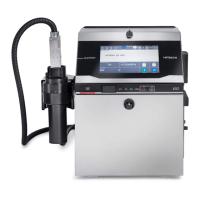38
(4) Relationship between print target detector signals and printing operation
The relationship between print target detector signals and printing operation is shown in the figure below.
(*1): The minimum value of time of preparing for printing
depends on the dot matrix to be printed and the ink drop
use. See the table on the right for estimated time.
The precise time can be calculated by the formula
below using the set number of vertical dots, character
width, and ink drop use.
Required time of preparing for printing (*2)
= [Time of one scan × (N + 1)] (ms)
N: An integer that meets (Time of one scan × N) ≥ a. However, "a" depends on the table on the
upper right.
(*2): This is the time required for repeatedly printing of fixed characters. When you use the
communication function or 2-dimensional bar code function, this will be longer than the time
obtained by this formula.
(*3): Excitation frequency: Model UX2, 65 µm nozzle 1067K ....... 68.9 kHz
For excitation frequency, see the handling guidance of each ink.
(5) Tracking function
● This function achieves printing even when two or more print objects are positioned between the print
target detector and print head.
● Up to four print objects can be positioned between the print target detector and print head.
● This function cannot be exercised simultaneously with the repeat-printing function.

